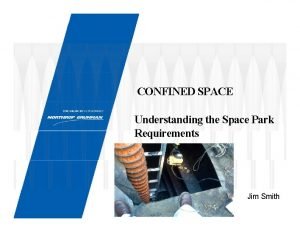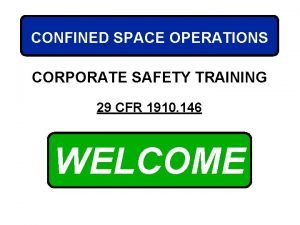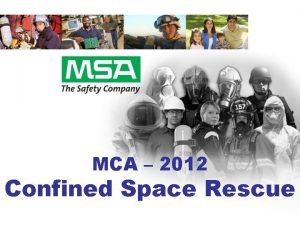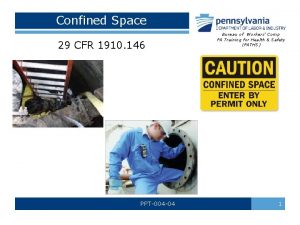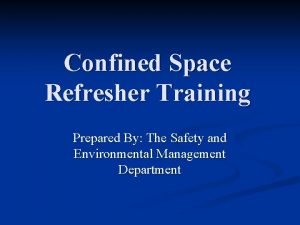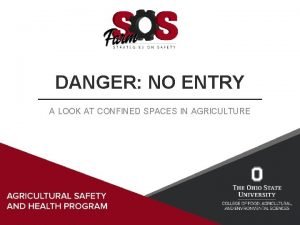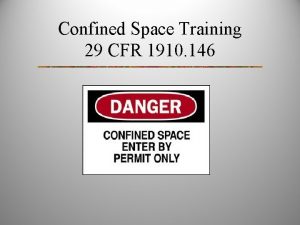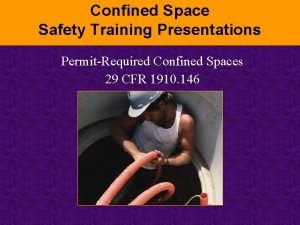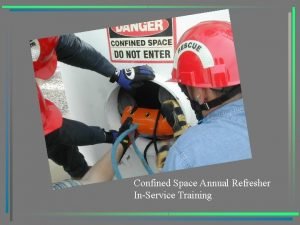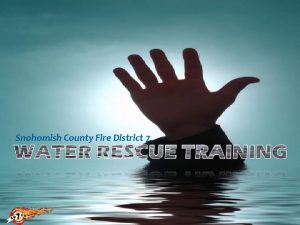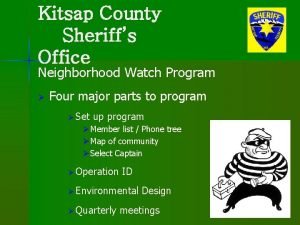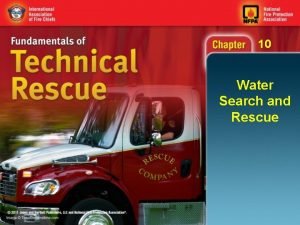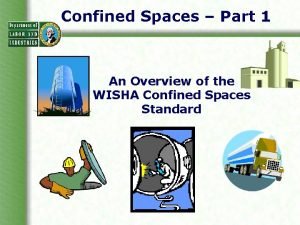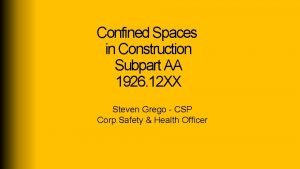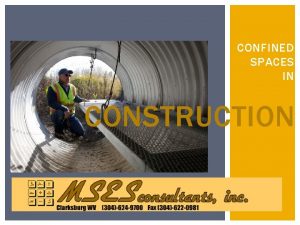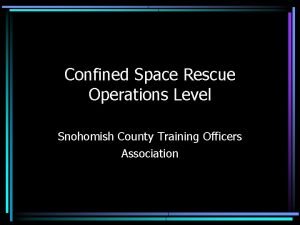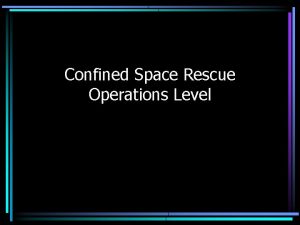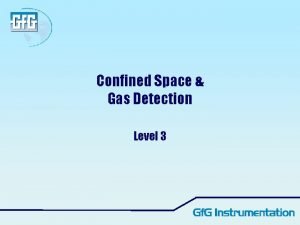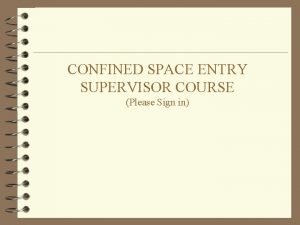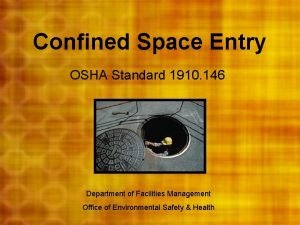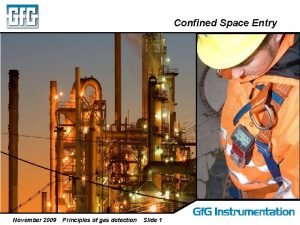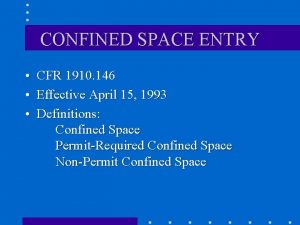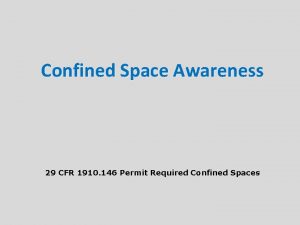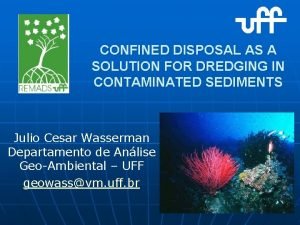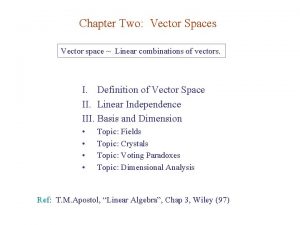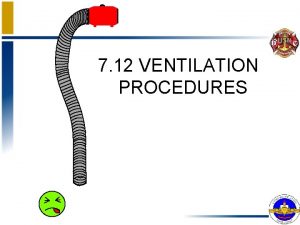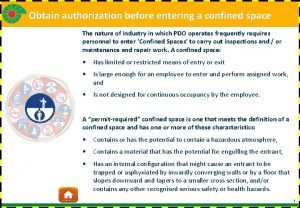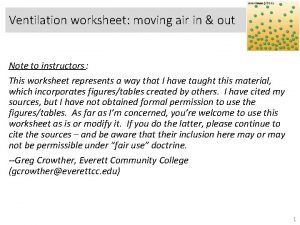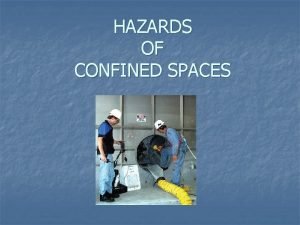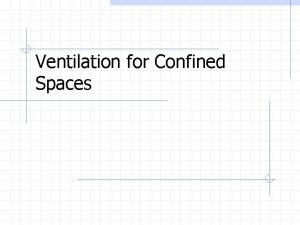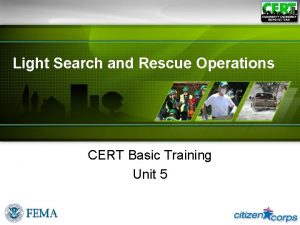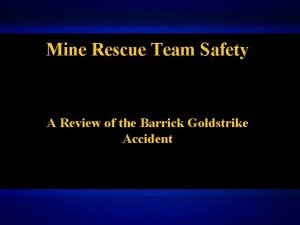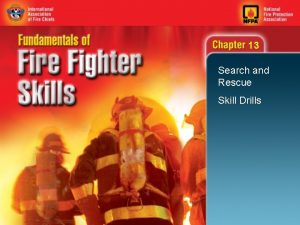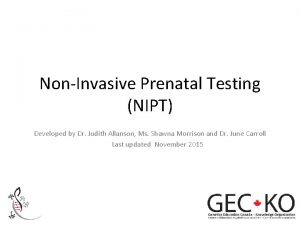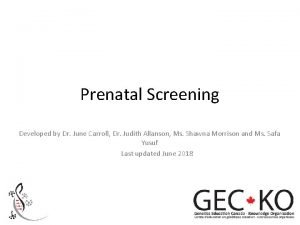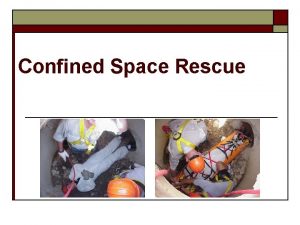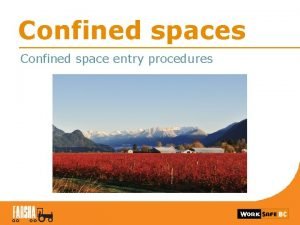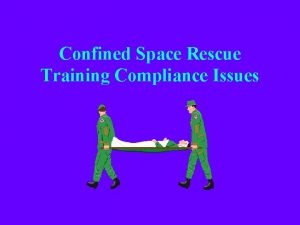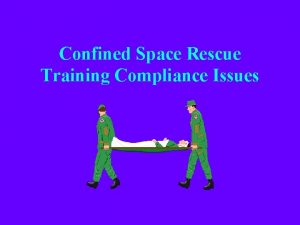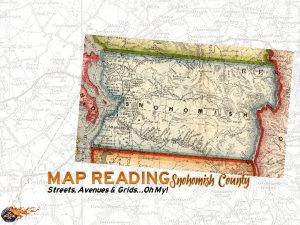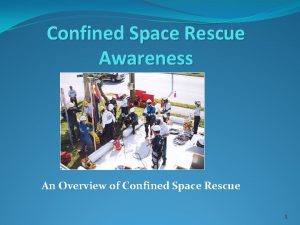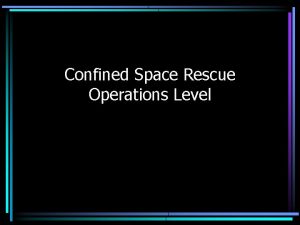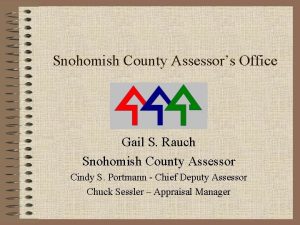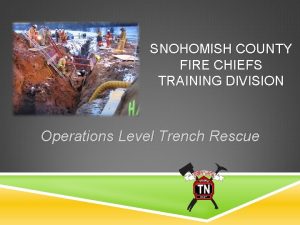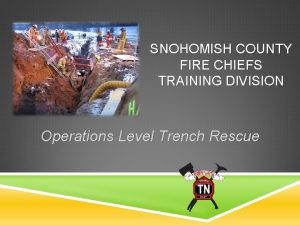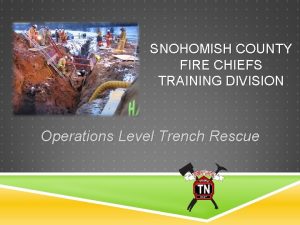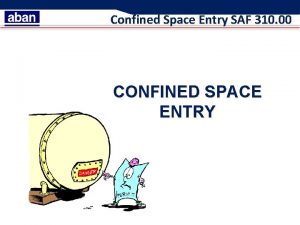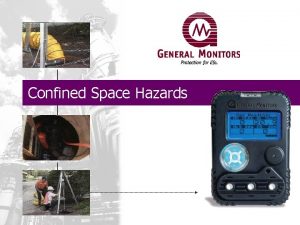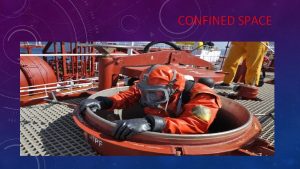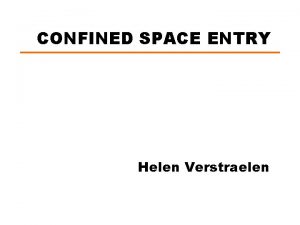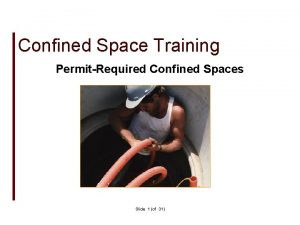Confined Space Rescue Operations Level Snohomish County Training













































- Slides: 45

Confined Space Rescue Operations Level Snohomish County Training Officers Association

Contents • Standard Operating Guideline • Equipment Review • Practical Application

Confined Space Standard Operating Guideline • • • A confined space shall be defined as a space that is large enough and configured so that an employee can enter it, has limited means of access and egress and is not designed for continuous occupancy. A permit required confined space meets all of the same requirements of a confined space plus one or more of the following: contains or has a potential to contain a hazardous atmosphere, contains a material that has the potential for engulfing an entrant, has an internal configuration such that an entrant could be trapped by inwardly converging walls or by a floor which slopes downward and tapers to a smaller cross section and/or contains any other recognized serious health hazards Any incident requiring rescue or removal of a victim from a confined space shall require the response of the Technical Rescue Team. No personnel shall enter a confined space without certified training and equipment to do so. Operations level personnel shall not enter a confined space, unless all of the provisions of guideline item #6 have been met.

Confined Space Standard Operating Guideline • • In general Operations level personnel shall be trained in recognizing a confined space, identifying hazards associated with a confined space and appropriate corrective measures to be taken to minimize the hazards of a confined space incident. Operations level personnel shall employ the following guidelines when faced with a confined space rescue incident: 1. Request a technical rescue response from dispatch. 2. Initiate the Incident management System (IMS)- including the establishment of a staging area for incoming units and personnel, as well as the implementation of the passport accountability system. 3. Isolate the scene and deny entry to prevent further danger to victim(s), personnel and bystanders.

Confined Space Standard Operating Guideline 4. Gather information: a. b. c. d. e. f. g. h. i. j. Rescue –vs- Recovery Cause of incident What function was the victim(s) performing in the confined space Nature of injury or problem i. Structural ii. Mechanical iii. Atmospheric iv. Personal Number of victims Specific victim information Location of victim(s) Location of alternative entry/access points Permit required or non-permit required space Identity of attendant or reporting party

Confined Space Standard Operating Guideline 5. 6. Advise dispatch and incoming units of updated, detailed information. Attempt to obtain: a. b. c. 7. 8. Blueprints of facility Drawing or cross sections of actual confined space in question Copy of victim’s entry permit Begin filling out the Fire Department Confined Space Entry Permit. Identify any possible or potential hazards and take the appropriate steps to minimize or remove them. a. b. c. Lock-out Tag-out procedures for utilities and machinery Structural collapse or instability issues Atmospheric conditions

Confined Space Standard Operating Guideline 9. Assist the Technical Rescue Team as directed, staying within the scope of Operations Level training. Tasks to include: a. b. c. d. e. f. Serve as a haul team member Operate safety lines Set-up and operate ventilation and other rescue equipment Monitor and run the air supply and communication systems Air monitoring Locking out and tagging out utilities.

Confined Space Standard Operating Guideline 9. Operations level personnel may attempt to perform a rescue if ALL of the following criteria are met: a. b. c. d. e. f. g. h. It is a rescue, not a body recovery The victim is visible Victim is within 25’ of the entry point, straight access Entry is a horizontal access SCBA is utilized and is able to remain on the firefighter’s back at all times Full turnout gear is worn- hood, gloves, pants, coat, helmet and boots A tagline is attached to the rescuer All hazards have been addressed

Confined Space Standard Operating Guideline 11. Keep all unnecessary communications to a minimum during rescue operations.

Equipment Review

Ventilation Equipment • “The purpose of ventilation in a confined space is to replace the oxygen-deficient, flammable, or toxic environment with clean air, and ultimately to eliminate the atmospheric hazards. ” CONINED SPACE RESCUE, Sargent, Chase. 2000, Fire Engineering Books & Videos

Ventilation Equipment • The primary piece of ventilation equipment is the electric powered, positive pressure blower with ducting • The electric blower should be placed as close to the entry point, of the confined space, as possible. Make note of the wind direction and ensure that fresh air is being introduced to the space.

Ventilation Equipment • Additional adaptors for use with the positive pressure blower include: – The 90* elbow, used for placing the ducting around corners or for use in placing the ducting down a vertical shaft while minimizing bends that would restrict air flow. – The “saddle” adaptor is generally used when placing ducting into a narrow entry area. This allows for the placement of ducting while maximizing space for the rescuer to enter

Supplied Air Breathing Apparatus SABA • The supplied air breathing apparatus, in contrast to our SCBA, supplies the rescuer with a near endless supply of air in which to enter the confined space and perform work. This is accomplished through the use of a manifold system and the use of standard SCBA bottles. This system is used in conjunction with an escape bottle for the rescuer

Supplied Air Breathing Apparatus SABA • The manifolds are typically stored in a hard plastic “Pelican” cases. Check with your TRT member for location and familiarity • Upon opening the case you will find two complete, and separate manifolds for use. One case will be used for the entry team. The other case is for the stand-by/ back-up team.

Supplied Air Breathing Apparatus SABA • • • Begin set-up by identifying the manifold to be used by the entry team. Either can be used for this purpose. Retrieve two bottles, plus as many spares as possible, and attach the two bottles to the hose fittings located on the manifold. Do not begin operations until a cache of spare bottles have been secured. Once the bottles have been attached you may turn on one of the bottles to charge the system. Please note that the manifold system operates from only one bottle at a time. Do not operate with bottles on at the same time.

Supplied Air Breathing Apparatus SABA • Internal to the manifold system is a • • • check valve. This allows for the highest air pressure to provide the air to the system. By charging the system with one bottle the valve allows air to enter from this side. Once this bottle is low we may charge the second bottle, thus overriding the valve and allowing the second bottle to provide the air for the system. Once we are operating off of bottle #2 we may bleed off and disconnect bottle #1; then replace with a fresh bottle Repeat the above steps to ensure that there is always a fresh bottle to charge the system when the one you are operating from has been depleted.

Supplied Air Breathing Apparatus SABA • • Once the system has been charged we may attach the air line portion of the “umbilicus”. To do this- find the “male” end of the air line, from the “umbilicus” or the patient line, and insert it into one of the “female” ports on the manifold. Please note that Locking Foster fittings are utilized on the manifold • To connect to the “locking Foster fitting” align the “notch” in the female fitting with the “raised point” on its post and press down on the “female” fitting. Insert the “male” end and release. Now turn the “female” fitting so it is no longer aligned and duct tape the connection for safety

Supplied Air Breathing Apparatus SABA Patient Line Rescuer “Umbilicus” • Once the manifold has been charged and lines attached for the rescuers you may begin to set up the back-up team manifold in the same manner as you had for the entry team. Please note that the entry team is working off this manifold and identified as Green and Yellow. Back-up would be Blue and Red in this scenario.

Supplied Air Breathing Apparatus SABA • Some key points regarding the SABA manifold system: – Maximum length of airline allowed for a user on the system is 300’ – Operations are performed using only one SCBA bottle at a time – Please keep the dust caps in place on all air line and communication cable fittings when not being used – Two manifolds will be in use on every entry. One for the entry team and one for the back-up team.

SABA Escape Bottle • Used in conjunction with the supplied air breathing apparatus manifold is the emergency escape bottle. This bottle is a self contained 10 minute escape bottle for use in emergency situations only. • The bottle is worn by the rescuer via its attachment to a waist belt. On this waist belt you will find the attachment point for the SABA air line and the mask mounted regulator for our SCBA masks. 1 2

SABA Escape Bottle • Please note that the escape bottle is not supplied by the SABA manifold. It is imperative that this escape bottle remain “off” until the rescuer is hooked up to the supplied air. Then turned on. • Our new SABA escape bottles have an automatic transfer switch if the supplied line is disrupted. The vibra-alert will activate and emergency egress will begin.

SABA Lines Umbilicus • “Umbilicus” lines can be found in large, black bags or plastic bins. Contact your TRT member for location and familiarity. • Each bag or bin is color coded to match the color of the umbilicus and the color code of the SABA escape bottles as well

SABA Lines Umbilicus • In each of the color coded bags/bins there is a 150” red, yellow, blue or green, “umbilicus”. • The “umbilicus” is simply a sheath that contains the air line, hardwire communication line and the tag-line for the rescuer.

SABA Lines Umbilicus • The “umbilicus” is stored coiled, using an over/under method of coiling to help ensure kink free deployment. • A close-up detail of the rescuer end of the “umbilicus” – Black line is the air line – Orange line is the hardwire communication line – Carabiner and tag-line is attached to the dorsal connection of the Class III harness

SABA Lines Umbilicus • Some key points regarding the “umbilicus” – Each bag contains two separate sections. One 50’ section and one 100’ section. They are coupled together to make a single 150’ “umbilicus”. – Coiled in an over and under method to keep the kinks out of the line when deploying – Neatness and organization is the key to successful deployment of the “umbilicus”. – Connections utilize “Locking Foster” fittings

Lock Out/ Tag Out • The Lock Out / Tag Out process is a critical component of confined space rescue. • Engine companies have LO/TO kits that you should be familiar with.

Lock Out / Tag Out Procedure • Once a utility/hazard is Locked Out the key is returned to the Rescue Group Leader. • All keys from locked out hazards are placed in the key box. • Each entrant has their respective lock that now secures the keys within the box. • The box and entrant keys stay in control of the Rescue Group Leader until the hazards are clear the rescue is complete.

Lock Out / Tag Out • This method of locking out hazards is standard in industry. • If a hazard is unable to be locked out a FF will need to be posted to secure the site.

Communication System • • • The Con-Space communication system is a hard wire system that allows for constant monitoring of communications with the entry team in a confined space incident. The equipment for this system is stored in a “Pelican” type briefcase. Contact you TRT member for location and familiarity. Components include: – – 2 headsets 1 control box 1 splitter 2 hard wire lines for headsets

Communication System • Setting up the communication system for use will require multiple connections to be made to the control box (1). All connections in this system are made by aligning the raised point of the “female” (2) fitting with the accompanying orange dot on the “male” (3) fitting. Once connected turn the “female” fitting to the Right to lock-in. 1 3 2

Communication System • • • The headset for the Entry Officer is recognizable by the fact that in both of its ear portions it contains padding and speakers. This enables the Entry Officer to direct all of his/her attention to the team in the confined space. The hard wire line is also recognizable as it does not contain a “lock-out” device, preattached, on it. This allows the controller to be in constant contact with the entry team. The connection for the hardwire is made on the rear of the control box under the label “controller” and the opposite end attached to the headset worn by the controller

Communication System • The air manager’s headset differs from the entry officer’s headset in that it contains padding and a speaker in only one side of the head set. This allows the air manager to monitor the entry team and entry officer as well as hear the audible low air warning device on the SABA manifold system. This is important as the communications system and SABA system will generally be set-up in close proximity to one another, and both systems operated by one individual.

Communication System • • The air manager’s hardwire line is shorter than the entry officer’s line and also contains a “lock-out” device (1) that enables the air manager’s microphone to be disabled when necessary. While the microphone is disabled he/she will still be able to hear all of the communications between the controller and the entry team. The connection point for the air manager’s line is located on the top of the control box, under the label “air mgr”. 1

Communication System • The entry and back-up teams will operate from a “splitter” device. Located on the rear of the control box, adjacent to the connection point for the controller, you will find labels indicating “Team 1” and “Team 2”. Into these connection points you will attach the splitter device that enables a total of 4 hardwire connections into it. Two are for the entry team and two are for the back-up team. All connections are made precisely as described in previous slides

Communication System • • Here we see the communication system set up for the entry team. Note that the splitter device is secured into the ports on the rear of the control box and there are two lines, one for each member of the entry team, connected in to the splitter. The remaining ports on the splitter would then be connected to the lines of the back-up personnel. The switch in the middle of the splitter device enables the air/communications manager to turn communications on or off for each team. The switch allows for both the entry and back-up teams to always be heard but allows for one or the other’s voice to be turned off, so as not to interfere with the overall operation.

• • • Communication System The ear piece and throat microphone enable the rescuer to transmit and receive information in a hands-free manner. Running from the control box, or splitter, to the rescuer is the communication hardwire line- contained in the umbilicus. This is then connected to the ear piece and throat microphone using the same type of connection described for the control box. The ear piece fits over the ear allowing the speaker to rest over the ear opening, and the microphone is placed on the throat and tested for clarity

Dressing the Confined Space Rescue Technician • In most instances the Rescue Technician will be able to don their confined space gear without assistance from others. However, there may be some need for help with SABA and communications line connections.

Dressing the Confined Space Rescue Technician • Once the Class III harness has been donned the emergency escape bottle is donned and the waist belt secured. • The SABA air line, from the umbilicus, can then be attached to the port of the first stage regulator on the escape bottle’s waist belt.

Dressing the Confined Space Rescue Technician • • Next, the carabiner and tag line may be attached to the dorsal connection point on the rescuer’s Class III harness. The communications line can then be routed up over the right shoulder, secured with the attached clip to the right shoulder “D-ring” to provide strain relief, and the fitting draped over the shoulder for later connection to the ear piece and microphone.

Dressing the Confined Space Rescue Technician • Once the ear piece and the microphone have been properly donned the connection to the communications line can be made. Please note that the wires for the ear piece and the microphone have small clips that may be used to secure them to the rescuers jumpsuit/BDU’s as strain relief.

Dressing the Confined Space Rescue Technician • • Final preparations would include: a helmet, SCBA mask, secondary light source, gloves and personal air monitor. Once the rescuer has completely and correctly donned all gear he/she must pass a safety inspection, including a check of the communications system and its operation, insuring that the air line is supplying air to the rescuer and that their escape bottle is now turned on. As well as inspection of all connection points and safety systems.

Practical Application • Please arrange a time with your shift’s TRT crew to review the preceding equipment, its location along with properation and set-up. • Also review the protocols as they relate to confined space rescue.

Please Note • No one agency can fully operate a permit required confined space rescue. • We will have multiple mutual aid agencies assisting. • All SABA fittings and con-space equipment is compatible county wide. • Each respective agency has a slightly different umbilical line configuration, but the process remains the same.

FURTHER TRAINING……. • It is highly encouraged that operations level personnel take the time to review their departments “tech” level equipment. For District #1 folks, schedule a meeting with TR 21 crew to achieve this.
 Confined space rescue equipment
Confined space rescue equipment Confined space rescue equipment
Confined space rescue equipment Confined space rescue equipment
Confined space rescue equipment Confined space rescue powerpoint presentation
Confined space rescue powerpoint presentation Confined space rescue equipment
Confined space rescue equipment Osha confined space training powerpoint
Osha confined space training powerpoint Confined space refresher
Confined space refresher Agricultural confined space training
Agricultural confined space training Osha 1910 confined space
Osha 1910 confined space Confined space training presentation
Confined space training presentation Confined space quiz
Confined space quiz Confined space refresher training
Confined space refresher training 211 snohomish county
211 snohomish county Snohomish county sheriff south precinct
Snohomish county sheriff south precinct Snohomish county fire district 7
Snohomish county fire district 7 Kitsap county sheriff's office
Kitsap county sheriff's office Differentiate surf rescue to water swift rescue
Differentiate surf rescue to water swift rescue Confined space gas limits
Confined space gas limits Osha 1926 confined space
Osha 1926 confined space Confined space meaning
Confined space meaning Saba confined space
Saba confined space Saba confined space
Saba confined space Confined space gas limits
Confined space gas limits Confined space supervisor course
Confined space supervisor course 1910 146
1910 146 Uel and lel
Uel and lel 1910 confined space
1910 confined space 1910 146
1910 146 Suspended particulate matter
Suspended particulate matter Characteristics of confined space
Characteristics of confined space Confined space vector
Confined space vector Ventilation calculation formula for confined space
Ventilation calculation formula for confined space Obtain authorization before entering a confined space
Obtain authorization before entering a confined space Ventilation worksheet
Ventilation worksheet Confined space classification
Confined space classification Confined space definition bc
Confined space definition bc 1910 confined space
1910 confined space Cert size up steps
Cert size up steps Pierce county search and rescue
Pierce county search and rescue Snohomish naturopathic clinic
Snohomish naturopathic clinic Mine rescue 17-3
Mine rescue 17-3 Mine rescue level 13-5
Mine rescue level 13-5 But now i am cabined, cribbed, confined, bound in analysis
But now i am cabined, cribbed, confined, bound in analysis Sips vs nipt
Sips vs nipt Unconfined aquifer definition
Unconfined aquifer definition Confined placental mosaicism
Confined placental mosaicism
